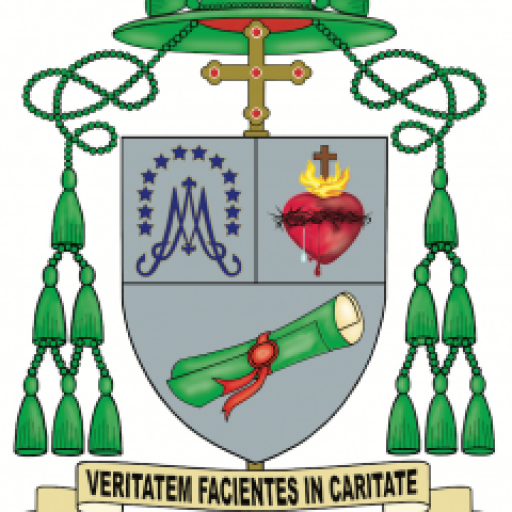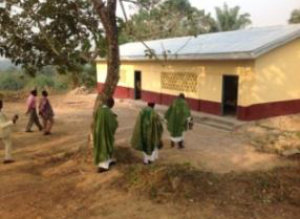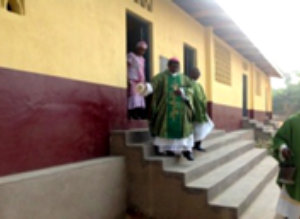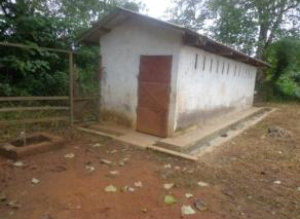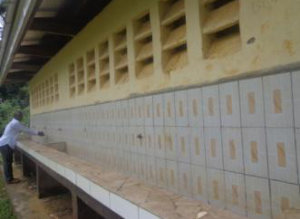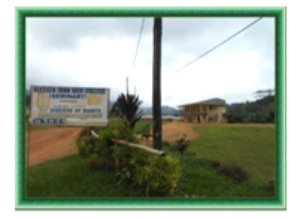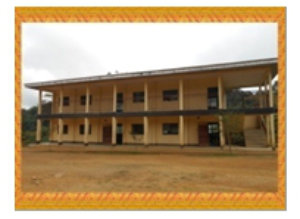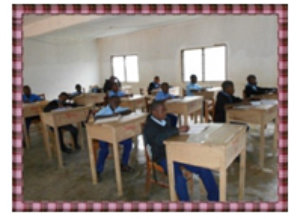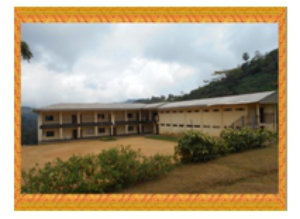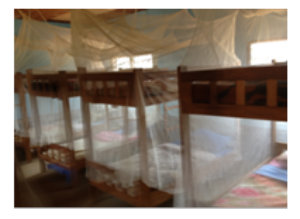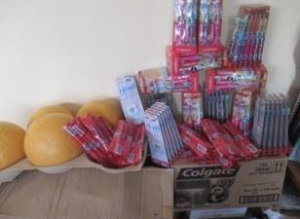CATHOLIC EDUCATION INSTITUTIONS IN THE DIOCESE OF MAMFE.
From 1999 when the Diocese was created right up to 2008, the Diocese could boast of three officially recognized secondary schools. These were: Queen of the Rosary College Okoyong Mamfe, Our Lady Seat of Wisdom College Fontem, and Saint John’s College Nchang. There was also a Girls Vocational Centre in Akwaya run and owned by the Tertiary Sisters of St. Francis of Assisi. All the Educational Institutions we had in the Diocese of Mamfe prior to 2009 were schools we inherited from the Diocese of Buea. In 2009, we had authorization to create and run a new secondary school called Saint Anthony of Padua’s College (S.A.P.A COL) situated in Mamfe town. In the same year, the Government gave us authorization to upgrade Saint John’s College Nchang into a High school. The chain of blessings would continue with authorization which the Holy See later on gave the Diocese to open its own Minor Seminary called Blessed John XXIII Minor Seminary, situated at Fotabong.
There are also the following colleges:
- St. Ignatius of Antioch college, Bachuo Akagbe
- St. Francis College, Mbeme
- St. John Paul II College, Nkongle
Education Secretariat
CES: Some Catholic Educational Secretariat Staff
Primary Schools
Renovation of Catholic Primary School Okoyong and Construction of Primary schools.
About one hundred and fifty pupils resident in Okoyong community benefit from the six refurbished classroom facility which was restructured with funds from the Pontifical Missionary Society (Holy Childhood, Rome). The support has enabled pupils who dropped out of school or transferred to far off schools to once more acquire primary education in a nearby location and in a dignified environment.
Construction of Ekok Primary school was begun with plans to continue work once additional funds are secured. Holy Childhood provided funds for the first phase of the project.
St Joseph School Mamfe and Catholic School Bachuo Akagbe also experienced construction of their toilets and dining shade which added to their hygiene and dignity as pupils so testified. A total of about five hundred pupils are presently enjoying the facility.
CES: Renovated Catholic Primary School in Okoyong
CES Toilets and food shade at St. Joseph and CS Bachuo Akagbe
CES Modern Toilet at St. John’s College funded by by Friends of Mamfe Diocese in Nurtingen Parish, Germany.
Construction of Six Class Rooms for St. John XXIII College, Nkongle.
The school was converted from Catholic School Nkongle so as to give the opportunity to the indigenes to attain secondary education in an institution that promotes moral rectitude in addition to high academic standards. The Focolare Movement funded the execution of the project with the hope to instill in students the Charism of Love and moral rectitude that they themselves live by.
CES: Picture of St. John XXIII Minor Seminary Nkongle Classrooms
Construction of two Dormitories for St John XXIII Minor Seminary, Fotabong.
The former dormitory which was far off on the hills from the classrooms which are located below the hills caused enormous stress to students who had to climb back to the structure about four times daily after class sessions and meals. The Rector then made a request to the Pontifical Missionary Society (Propaganda Fidei) that funded two dormitories for the institution. The new facility has enabled students to concentrate in class with effect of improved academic performance and comfort in their study conditions.
CES: Picture of St. John XXIII Minor Seminary Dormitory in Fotabong
Donation of Toilet items (tooth brushes and paste and bathing soap ) to schools in Mamfe Diocese
This gesture was made possible thanks to a friend of the Diocese, a medical doctor by profession. About 10,000 students benefitted from this largesse which contributed to personal hygiene and dignity of the school children. The gifts were provided in a bid to limit dermatological and dental problems which are common problems in rural areas promote hygiene from early ages of livelihood thus the selection of the target population of school children.
CES: Picture of Donated Toilet items to schools
Setting up modern audio visual pedagogic equipments in ten Primary Schools.
It was a pilot project that saw the supplies of pedagogic materials to some pilot schools in the Ecclesiastical Province of Bamenda. These materials include T.V sets, lots of didactic materials and a decoder for the projection of films. About three thousand pupils benefit from this pedagogic material that were provided by a U S based NGO called Opportunity Education
CES: Pupils in modern audio visual centre
A. STATISTICS FOR OUR CATHOLIC PRIMARY AND SECONDARY SCHOOLS FOR THE PAST FIVE YEARS
Taken from the Diocesan Catholic Secretariat, the statistics of our Catholic primary and secondary schools have been given bellow:
| STATISTICS FOR OUR PRIMARY SCHOOLS | |||||
| 2007-2008 | CATHOLICS | PROTESTANTS | MUSLIMS | OTHERS | TOTAL |
| Boys | 1775 | 82 | – | 30 | 1887 |
| Girls | 1701 | 70 | – | 60 | 1831 |
| Total | 3476 | 156 | – | 140 | 3718 |
| 2008-2009 | |||||
| Boys | 1819 | 118 | 7 | 130 | 2074 |
| Girls | 1610 | 127 | 18 | 127 | 1882 |
| Total | 3429 | 245 | 25 | 257 | 3956 |
| 2009-2010 | |||||
| Boys | 1360 | 437 | 97 | 74 | 2004 |
| Girls | 1324 | 429 | 54 | 59 | 1866 |
| Total | 2684 | 902 | 151 | 133 | 1870 |
| 2010-2011 | |||||
| Boys | 1162 | 522 | 46 | 116 | 1846 |
| Girls | 1279 | 610 | 59 | 20 | 1968 |
| Total | 2441 | 1132 | 105 | 136 | 3814 |
| 2011-2012 | |||||
| Boys | 1172 | 431 | 32 | 73 | 1708 |
| Girls | 1335 | 419 | 76 | 78 | 1908 |
| Total | 2507 | 850 | 108 | 151 | 3616 |
| STATISTICS FOR TEACHERS OF OUR PRIMARY SCHOOLS | |||||
| 2007-2008 | CATHOLICS | PROTESTANTS | MUSLIMS | OTHERS | TOTAL |
| Men | 68 | – | – | – | 68 |
| Women | 28 | – | – | – | 28 |
| Total | 96 | – | – | – | 96 |
| 2008-2009 | |||||
| Men | 75 | 3 | – | 2 | 80 |
| Women | 30 | 2 | – | 2 | 24 |
| Total | 105 | 5 | 4 | – | 114 |
| 2009-2010 | |||||
| Men | 61 | – | – | – | 61 |
| Women | 43 | 1 | – | – | 44 |
| Total | 104 | 1 | – | – | 105 |
| 2010-2011 | |||||
| Men | 69 | – | – | – | 69 |
| Women | 54 | 2 | – | – | 56 |
| Total | 123 | 2 | – | – | 125 |
| 2011-2012 | |||||
| Men | 70 | – | – | – | 70 |
| Women | 61 | 3 | – | – | 64 |
| Total | 131 | 3 | – | – | 134 |
| STATISTICS FOR STUDENTS OUR SECONDARY SCHOOLS | |||||
| 2007-2008 | CATHOLICS | PROTESTANTS | MUSLIMS | OTHERS | TOTAL |
| Boys | 275 | 30 | 1 | 7 | 313 |
| Girls | 586 | 20 | 2 | 5 | 612 |
| Total | 861 | 50 | 2 | 12 | 925 |
| 2008-2009 | |||||
| Boys | 310 | 30 | 1 | 4 | 345 |
| Girls | 570 | 18 | 1 | 6 | 595 |
| Total | 880 | 48 | 2 | 10 | 940 |
| 2009-2010 | |||||
| Boys | 244 | 61 | 6 | 15 | 326 |
| Girls | 431 | 112 | 17 | 13 | 583 |
| Total | 675 | 183 | 23 | 28 | 909 |
| 2010-2011 | |||||
| Boys | 262 | 66 | 10 | 21 | 359 |
| Girls | 455 | 96 | 23 | 40 | 614 |
| Total | 717 | 162 | 33 | 61 | 973 |
| 2011-2012 | |||||
| Boys | 324 | 64 | 10 | 3 | 401 |
| Girls | 440 | 149 | 15 | 17 | 621 |
| Total | 764 | 213 | 25 | 20 | 1022 |
| STATISTICS FOR TEACHERS OF OUR SECONDARY SCHOOLS | |||||
| 2007-2008 | CATHOLICS | PROTESTANTS | MUSLIMS | OTHERS | TOTAL |
| Men | 40 | 2 | – | – | 42 |
| Women | 16 | 1 | – | – | 17 |
| Total | 56 | 3 | – | – | 59 |
| 2008-2009 | |||||
| Men | 50 | 3 | – | – | 53 |
| Women | 13 | 2 | – | – | 15 |
| Total | 63 | 5 | – | – | 68 |
| 2009-2010 | |||||
| Men | 38 | 2 | – | – | 40 |
| Women | 16 | 1 | – | – | 17 |
| Total | 54 | 3 | – | – | 57 |
| 2010-2011 | |||||
| Men | 45 | 5 | – | – | 50 |
| Women | 33 | 1 | – | – | 4 |
| Total | 78 | 6 | – | – | 84 |
| 2011-2012 | |||||
| Men | 60 | 4 | – | – | 64 |
| Women | 16 | 2 | – | – | 18 |
| Total | 76 | 6 | – | – | 82 |
B. THE DIOCESAN CATHOLIC EDUCATION COUNCIL (D.C.E.C)
The Diocesan Catholic Education Council is the highest organ in the Education sector of the Diocese. It is the body that advises the Bishop and makes policies in matters of Education. The Bishop himself is the president of this council and His Education secretary is the Secretary. Membership in the council comprises of different stakeholders and other partners of Catholic Education in the Diocese. These include all the principals of Catholic Colleges in the Diocese, the representatives of the Focolare movement, selected seasoned Educationists who are also are fervent Catholics, and some representatives from the Ministry of Basic and secondary Education, labour and social security and the Ministry of lands. The members of this council have the singular responsibility of speaking out for Catholic Education and of sensitizing the people of the Diocese to see the need for Catholic Education. So far, this council has been very active and helpful to the Bishop. The creation of institutions like Saint Anthony of Padua’s Secondary school Mamfe and the High School of Saint John’s College Nchang were all ideas given by members of this council. The members are also doing a great job of sensitizing the people in their various Parishes about the importance of Catholic Education. For the coming school year, the council has for its major prospect the establishment of pre-primary school alongside the already existing primary schools throughout the Diocese.
C. THE PARENT TEACHERS’ ASSOCIATION
It is a re-union of teachers and parents who have their children in the Catholic School. They meet together to discuss ways that they can help form their children better in the light of the philosophy of the Catholic school. This association also carries out fundraising in the form of levies to assist the Bishop in the different Education Sector, such as the provision of didactic materials to schools, renovation of old structures and motivation to teachers, students and pupils to encourage hard work and excellence.
D. RELIGIOUS EDUCATION IN OUR SCHOOLS
Catholic Education is obligatorily taught to all pupils and students in our primary schools and colleges. At the end of primary school, the child receives the First school Religious Certificate, if he/she successful in the final year Religious exam set by the Bamenda Ecclesiastical Provincial Catechetical team.
At the secondary level, students receive two Religious certificates. The first at the Junior level obtained after the third year, the second at the senior level obtained after the sixth year. Both certificates are awarded be the Provincial Religious Studies Examination (C.R.S.E) board. the content of Religious Education in our schools and colleges comprises of studies in the Creed, the Sacraments, the commandments, prayers and the liturgy, as well as in the sacred scriptures.
It worth noting that even though all the pupils and students in our schools and colleges are expected to have at least a theoretical knowledge of the Catholic faith by the end of their programme, only those who are Catholics are obliged to belief in its contents.
At the end of the fifth and seventh years of secondary school, some students also write a certificate exam on Religious studies which is organized by the General Certificate of Education (G.C.E) board.
Religious studies is only one of the subjects in the exam organized by the Board. This exam, whose content comprises mainly on studies in Sacred Scriptures, Morality and an introduction into the other major world religions is organized Ecumenically with leaders of other Religious denominations under the auspices of the Cameroon General Certificate of Education (G.C.E) board.
E. PROBLEMS FACING THE CATHOLIC EDUCATION IN THE DIOCESE OF MAMFE
1. LIMITED FINANCES
This problem is very serious at the primary level, where the school fees rates are very low. It is difficult to raise them because the state has opened many more public schools with little or no fees charged. With this, many parents prefer the public schools and so our schools are left with very low enrolments which can not guarantee their self-reliance and survival.
Similarly, we are also caught up in a situation of stiff competition with many emerging lay private schools, which are very effective, on account of the fact that they make use of very advanced and expensive methods of education. They however provide their services mainly to the children of the rich. So far, the Diocese of Mamfe has not abandoned its option for the poor. Our fees are still very low; to the tune of an annual amount of 10.000FRS CFA compared to the 150.000FRS CFA of some of these elitist lay private schools.
2. DISGRUNTLED CATHOLIC TEACHERS
With the very limited finances to run our schools, our Catholic teachers are also suffering greatly. Often they have to wait for several months before receiving their salaries. The Government has a policy of granting subvention to private Education but it does not consider itself obliged to do so. Often the subvention given is not enough to clear teachers’ salaries. The situation is so precarious that the Diocesan Catholic Education Council which took place in March this year has advised the Bishop to close down some of the schools with very low enrolments and take more effective care of the others. In this case, those teachers who are registered workers with the Diocese and who are serving in schools with very low enrolments shall be moved to more viable schools.
Naturally, the plight of the Catholic teacher has left many of them so disgruntled. Many of them have left the Catholic Education Agency to work with the Government and other more lucrative private employers. The Diocese is now left with a handful of lowly qualified and inexperienced teachers who cannot really deliver the goods. In the course of the last three years, much has been done to upgrade the skills of these teachers through frequent in-service training programmes.
